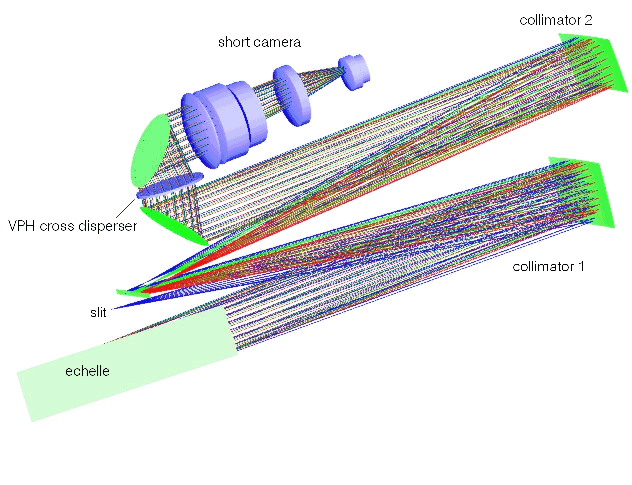
PEPSI is a high-resolution adaptive-optics echelle spectrograph with two polarimeters for the Large Binocular Telescope (LBT) in Arizona. It has been proposed and is currently being developed by the Astrophysical Institute of Potsdam (AIP), with a possible participation of an Italian Consortium of four INAF Institutes. The PI is Klaus Strassmeier (AIP); the Italian Co-PI is Roberto Pallavicini (OAPA). The Project Manager is Michael Andersen (AIP).
The unique design and large aperture of the LBT will allow the simultaneous observation with PEPSI of circularly and linearly polarized light with high spectral and time resolution. Each telescope will be equipped with an independent polarimeter in their direct f/15 Gregorian focii and two fibers per polarimeter will enter a single bench-mounted echelle spectrograph located in a temperature-controlled environment. Besides the polarimetric mode the spectrograph can also be fed directly with integral light including an adjacent sky position on one telescope and a calibration spectrum for accurate radial velocity determination on the other telescope. An ultra high-resolution (R = 250,000) adaptic-optics mode is also been considered.
The polarimeters feed a single spectrograph and a total of four spectra per echelle order will be imaged onto the detector. The spectrograph is designed for a resolution-slit product of R=40,000 for 1 arcsec entrance slit and will allow a wavelength coverage from 450 to 1000 nm in three to four exposures (selected by using different cross-dispersers). Two CCD cameras, one with 9.2K x 2K and one with 4.6K x 4K, with 13.5 micron pixels, will be employed for the two optical cameras. The standard camera is f/3.0 and the high-resolution camera is f/4.9. Using four 1 arcsec fibres (200 micron), with 2 arcsec interfibre space, minimum interorder separation is 8 arcsec. Different sets of fibres with varying diameters (as small as 0.2 arcsec corresponding to fibers of 40 micron diameter) can be used with adaptive optics in order to obtain very high resolutions (up to 250,000). The 9.2K x 2K CCD array is needed for the highest resolution mode with the second, long-focus camera.
INAF has participated in the design phase of the instrument through the Observatories of Brera, Palermo and Catania. Researchers at Brera and Palermo have designed a high-resolution echelle spectrograph (ICE) for PEPSI and have investigated the possibility of an ultra high-resolution mode taking advantage of the adaptic optics correction provided by the LBT secondary mirror. Participation of INAF at the construction of the instrument is still pending depending on the availability of the required funds and manpower. Should Italy withdraw from the project, PEPSI may suffer some descoping to meet the original goal of first light at the telescope in 2006.
Technical information on the PEPSI project can be found at the official PEPSI Web site at AIP (URL address: www.aip.de/pepsi).
A preliminary design for the echelle spectrograph for PEPSI is given in the following paper:

last update: 2004, 15 Feb